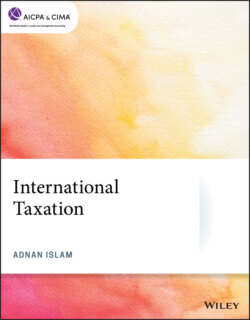Читать книгу International Taxation - Adnan Islam - Страница 28
Taxation of an IC-DISC
ОглавлениеAn IC-DISC is categorized as a domestic C corporation that is tax exempt for federal income tax purposes. However, to obtain this tax exempt status, the corporation must file Form 4876-A, Election to Be Treated as a DISC, within 90 days of its first taxable year. If the corporation elects to be treated as an IC-DISC moving forward, then the election must be made within 90 days before the beginning of the first taxable year of the DISC. The election must be signed by all shareholders as of the effective date of the election. Once made, the election is effective for all subsequent years until it is revoked by the corporation. Based on foreign sales of products manufactured, produced, grown, or extracted in the United States, the exporter pays a commission to the IC-DISC and then deducts the commission from its ordinary business income. This results in a deduction at ordinary tax rates. The IC-DISC receives the commission without having to pay federal tax on the income. In most cases, the IC-DISC then distributes this cash as a dividend to its shareholders. As long as the shareholders are individuals or pass-through entities such as S corporations or partnerships, the dividend is taxed at the favorable qualified dividend tax rates.
For example, say an S corporation hops grower has domestic gross receipts of $25m and foreign gross receipts of $15m for a total of $40m. The cost of growing, harvesting, drying, and bailing the hops — which will be sold both domestically and overseas — leaves the gross margin at $8m. Take out general expenses, and the grower’s net taxable income is now $3.75m domestically and $2m internationally. To determine the permanent federal tax savings using an IC-DISC, start by calculating its commission, which in this case can be either: 50% of export net income or 4% of export gross receipts (limited to export net income).
In this example, the first method gives us a commission of $1m (50% of $2m, the grower’s net taxable international income), and the second gives us a commission of $600,000 (4% of $15m). Generally, the taxpayer will want to choose the larger of the two amounts for the greatest tax benefit. In this case, the first choice results in a $1m commission paid by the grower to the IC-DISC. As a result of this commission, the grower’s taxable income is reduced by $1m. Because the grower is an S corporation, its shareholders report this income (now reduced by $1m) on their individual income tax returns. Assuming the shareholders are in the top tax bracket (and taxed at 37%), the commission payout results in a federal tax reduction of $370,000 in total for the shareholders. The $1m paid to the IC-DISC is taxed to the IC-DISC’s owners (when paid or deemed paid) as a qualified dividend at the 23.8% rate (factoring in the 3.8% NIIT tax), resulting in tax of $238,000. The difference between the ordinary income tax saved by the individual shareholders and the qualified dividend tax liability incurred by the IC-DISC results in a tax savings of $132,000. The IC-DISC may also choose not to pay a dividend to its shareholders. In this case, an interest charge would apply to the deferred tax (hence the entity’s name). The interest charges are based on Treasury bill rates, so at this time the potential interest charges are small. There are also deemed distribution rules related to qualified export receipts that exceed $10m; these rules can result in shareholders being taxed on the DISC’s earnings without there being an actual distribution.
